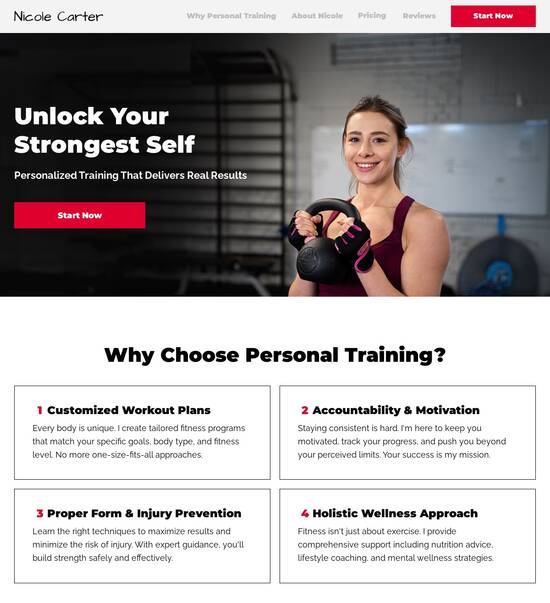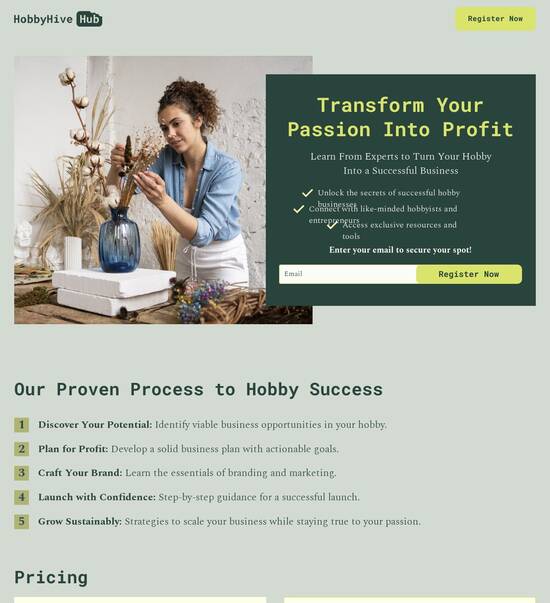
HTML page template for dress stores
Use TemplateAbout template
Showcase your products with stunning landing page templates for your dress stores. Ready to boost those sales?
Recommended templates

Easy to build without coding
With the intuitive drag-and-drop builder, anyone on your team can create high-converting pages without any knowledge of code or design. Make enhancements to your landing page with custom widgets using Javascript, HTML/CSS, or third-party scripts.

Multiple layouts for any industry and goal
Select from 500+ landing page layouts built to boost conversions across industry-specific scenarios. Customize them by adjusting fonts, adding images, and generating on-brand content with the AI assistant. Quickly scale with Instablocks® and Global Blocks that you can save, reuse, and update globally.

Loads fast and looks polished on any device
Every template is responsive, which means they present professionally on any device and load blazingly fast with our Thor Render Engine. You can also power them up with Google AMP technology to deliver an unparalleled mobile experience and drive higher conversions.

Robust analytics & experimentation
Get real-time updates and reporting across all your devices, showing the number of visitors, conversions, cost-per-visitor, and cost-per-lead. Launch AI-powered experiments, run A/B tests, and use heatmaps to analyze user behavior, then optimize your landing page to maximize conversions.







Easy to build without coding
With the intuitive drag-and-drop builder, anyone on your team can create high-converting pages without any knowledge of code or design. Make enhancements to your landing page with custom widgets using Javascript, HTML/CSS, or third-party scripts.
Multiple layouts for any industry and goal
Select from 500+ landing page layouts built to boost conversions across industry-specific scenarios. Customize them by adjusting fonts, adding images, and generating on-brand content with the AI assistant. Quickly scale with Instablocks® and Global Blocks that you can save, reuse, and update globally.
Loads fast and looks polished on any device
Every template is responsive, which means they present professionally on any device and load blazingly fast with our Thor Render Engine.
Robust analytics & experimentation
Get real-time updates and reporting across all your devices, showing the number of visitors, conversions, cost-per-visitor, and cost-per-lead. Launch AI-powered experiments, run A/B tests, and use heatmaps to analyze user behavior, then optimize your landing page to maximize conversions.
All the features you need to build lead-generating landing pages
Explore more featuresLearn how to build top-performing landing pages for any goal
FAQs
Leading the way in building high-performing landing pages





An ultimate guide to optimizing landing pages with Instapage
Optimizing your landing pages is crucial for maximizing ROI and enhancing your digital marketing campaigns. Instapage offers powerful tools that simplify this process, enabling marketers in fields ranging from business services to education to create high-converting landing pages quickly and efficiently. This step-by-step guide outlines how to utilize Instapage's features to boost your campaign's effectiveness.
Understanding Instapage's value for landing page optimization
Instapage is renowned for its ease of use, allowing marketers to create customized landing pages without needing extensive technical skills. Marketers can access over 100 ready-to-use templates and lead generation elements, empowering them to launch effective lead capture pages swiftly. The platform's intuitive builders make it accessible for users of all budgets and team sizes, ensuring you can effectively scale your marketing efforts.
- Templates: Choose from over 100 high-converting templates tailored for various industries.
- Lead generation elements: Incorporate pre-built elements designed to maximize conversions.
- Customization: Modify templates easily to align with your brand's voice and style.
Step 1: Launch your landing page
To begin your journey with Instapage, sign up and select a template that resonates with your campaign's goals. Focus on templates that emphasize conversion, especially for specific verticals like tech or finance.
Step 2: Optimize for conversions
After selecting a template, refine your landing page using Instapage’s built-in optimization features. Utilize heatmaps to analyze user interaction and adjust elements based on user behavior.
- A/B Testing: Experiment with different versions of your landing page to see which design wins.
- Heatmaps: Visualize where users click most often to understand behavior.
- Analytics Dashboard: Monitor your page performance and conversion metrics in real time.
Step 3: Personalization for higher engagement
Tailoring your content to meet the needs of your target audience can significantly increase engagement. Use dynamic text replacement to personalize the user experience and ensure your messaging resonates with visitors.
- Dynamic Text Replacement: Show users personalized content based on their preferences.
- AdMaps: Link specific ads to tailored landing pages for higher relevance.
- Audience Tracking: Monitor metrics at an audience level to gauge effectiveness.
By implementing these strategies within Instapage, you can create compelling landing pages that accelerate conversions and optimize your marketing campaigns effectively.
Ready to transform your landing pages? Start your free trial with Instapage today and see how you can enhance your marketing efforts!
People also ask about HTML page template for dress stores
Unveiling the Ultimate HTML Page Template for Dress Stores: A Deep Dive into Features and Benefits
Understanding the basic structure of HTML templates
An HTML page template serves as a foundation for creating engaging and functional websites, especially for dress stores. The basic structure of an HTML page includes essential elements such as the head, body, and footer. The head section typically contains metadata, title tags, and links to stylesheets, while the body houses the content that users see. The footer usually includes copyright information and additional links. Utilizing semantic HTML tags, such as , , , and , is crucial for enhancing search engine optimization (SEO) and improving accessibility.
In the context of dress stores, employing semantic HTML is essential as it provides context to search engines about the type of content presented. For instance, using tags for product descriptions increases clarity about the information being displayed. Moreover, having a well-structured HTML document aids in better performance across different devices, ensuring that users have a seamless experience regardless of how they access the site.
head: Contains metadata and links to stylesheets.
body: Houses the visually displayed content.
footer: Provides additional information and links.
The role of CSS in styling templates
CSS, or Cascading Style Sheets, plays a pivotal role in defining the visual appeal of an HTML page template. It allows designers to apply styles to various HTML elements, influencing aspects such as layout, colors, fonts, and overall aesthetics. For dress stores, thoughtful styling can significantly affect users' shopping experiences — a visually appealing site can attract customers and retain them longer.
To create a dress store website that resonates with fashion-conscious customers, designers should prioritize clean layouts that highlight products. Selecting the appropriate fonts and colors can also enhance the shopping atmosphere. For instance, using soft pastel colors can create a calming effect that mirrors the essence of elegance typically associated with fashion. Incorporating styles that are consistent with the seasonal collections can also make the website feel more tailored and updated.
Designing for the target audience: A customer-centric approach
Understanding the target audience is crucial in designing effective HTML templates for dress stores. Typically, dress store shoppers fall within diverse demographics, but they often share an affinity for fashion trends and quality. Women's clothing, in particular, represents a significant market segment. Understanding what these customers are looking for can greatly inform design decisions, from aesthetics to functionality.
To resonate with this audience, website designs should prioritize visual appeal, as fashion-focused customers are often drawn to vibrant imagery and slick layouts. A user-friendly navigation experience can further enhance their shopping experience. By organizing the menu items logically, ensuring easy access to various categories, and taking advantage of attractive front-page designs, dress stores can effectively guide shoppers to discover products that align with their fashion preferences.
Understand shopper demographics to tailor designs.
Prioritize a visually appealing website layout.
Ensure easy navigation for improved user experience.
Creating a user-friendly navigation experience
User-friendly navigation is a cornerstone of successful dress store websites. Organizing menu items into clear categories significantly boosts product discoverability. Potential customers should easily locate specific types of dresses, sizes, and colors without frustration. Moreover, incorporating tactical use of breadcrumbs not only aids navigation but also enhances the overall user experience, allowing customers to effortlessly retrace their steps.
Effective navigation also encourages users to explore more products, thereby increasing the chances of conversions. As users move from page to page, maintaining a consistent menu layout and design helps solidify familiarity with the site structure, making it easier for them to find exactly what they're looking for. This strategic organization of content ultimately leads to higher customer satisfaction and loyalty.
Essential features of an HTML page template for dress stores
When developing an HTML page template for dress stores, certain features are vital to enhance both functionality and user engagement. One critical aspect is product display mechanics, which should adhere to responsive design principles. This allows optimal viewing experiences across mobile and desktop devices, ensuring that customers can browse products regardless of their device.
Integrating product sliders and image galleries can further enhance the product display experience. These tools create dynamic and lively presentations of products, allowing customers to see various angles and styles. Incorporating an easy-to-use zoom feature can allow customers to inspect material details closely, which is crucial for online selling where feel and touch are unavailable.
Use responsive design for accessibility on all devices.
Integrate product sliders and galleries for visual appeal.
Consider adding a zoom feature for detailed product inspection.
Shopping cart and checkout integration
The shopping cart and checkout process are critical aspects of any dress store template. Integrating e-commerce functionalities generally requires including sections for adding products to the cart, updating quantities, and viewing total costs. A seamless and intuitive checkout experience is vital for reducing cart abandonment rates, which can have a substantial impact on sales.
An effective shopping cart allows users to easily navigate between their selections and continue shopping or proceed to checkout. Easy access to their previous actions or adjustments can significantly enhance customer satisfaction, guiding them toward completing their purchases without confusion or delays.
Search engine optimization (SEO) strategies for dress store templates
Optimizing HTML templates for SEO is pivotal to ensure dress stores attract organic traffic. Crafting meta descriptions and title tags that incorporate targeted keywords specific to fashion can significantly improve search engine rankings. It is important to focus on not only the primary keywords but also related terms that potential customers might use when searching for dresses.
In addition, structuring compelling meta descriptions attracts clicks from search results. Regularly reviewing and updating these elements based on market trends and keyword effectiveness can further optimize visibility. Comprehensively, these small adjustments can have notable impacts on user engagement and traffic flow.
Incorporate targeted keywords in meta descriptions.
Utilize compelling title tags to encourage clicks.
Regularly review SEO elements based on trends.
Building an effective sitemap.xml
Creating and submitting a well-structured sitemap.xml to search engines facilitates better indexing of the dress store website. A sitemap provides a clear blueprint of the website's hierarchy, helping search engines understand how to navigate the site. It is essential for informing these engines about newly launched products or changes, thus affecting visibility positively.
By ensuring that the sitemap is structured effectively with correct URLs and priority settings, e-commerce sites improve the chances of better SEO rankings. A thoughtfully designed sitemap can also assist in the user experience by showcasing important pages that customers might be interested in visiting.
Privacy and security considerations in your template
Maintaining compliance with privacy laws is a critical aspect of dress store web templates. With various data protection laws, such as GDPR and CCPA, sellers must establish transparent privacy policies. Displaying these policies effectively on the site can help build customer trust and demonstrate accountability.
Furthermore, securing customer data during transactions is non-negotiable. Implementing SSL certificates for data encryption protects sensitive customer information, particularly credit card details. Incorporating secure payment gateways also reassures customers about the integrity of their transactions, fostering loyalty and trust.
Ensure compliance with privacy laws like GDPR and CCPA.
Display privacy policies transparently on the site.
Implement SSL certificates for secure transactions.
Customization options to elevate brand identity
Customizing HTML templates allows dress stores to reflect their unique brand styles effectively. Tailoring colors, fonts, and layouts ensures the website aligns with the brand's identity. For instance, if a dress store focuses on vintage clothing, using retro-themed visuals can enhance brand representation.
Moreover, maintaining consistency in branding throughout the template is vital for customer recognition and trust. Utilizing plugins and widgets further enhances functionality and engagement. Essential plugins may include social media integration, while innovative widgets could allow for customer reviews or feature trending items, driving more interaction on the site.
Tailor colors, fonts, and layouts to reflect brand style.
Maintain consistency in branding for recognition.
Utilize essential plugins for added functionality.
The future of dress store templates: Trends from 2007 to 2025
The evolution of technology has influenced web design trends significantly. Since 2007, notable advancements include responsive design, improved e-commerce functionalities, and the rise of mobile shopping. Dress store HTML templates have adapted by incorporating these trends, providing users with efficient and engaging experiences.
Predications for the upcoming years suggest a focus on personalization and advanced integrations with AI. Future HTML templates may leverage AI to create tailored recommendations based on customer behavior, enhancing the shopping experience. Acknowledging these shifts in technology and staying updated with design practices is essential for maintaining relevance.
Notable advancements have influenced design methods significantly.
Emphasizing responsive design caters to mobile users.
AI technologies will enhance personalization in future templates.
Adapting to technological shifts
Adapting to technological changes is critical for dress stores aiming to stay competitive. Keeping templates versatile to accommodate future adaptations not only enhances customer experiences but also allows for seamless integration of emerging technologies. Regular updates and improvement of the website infrastructure will lead to sustained customer engagement and trust.
Moreover, it is essential to monitor design trends and customer preferences continuously to align the website's offerings. By embracing shifts in consumer behavior, dress stores can innovate their templates to meet evolving demands.
Performance optimization techniques for your dress store template
Fast loading times are crucial for retaining customers on dress store websites. Best practices for performance optimization include compressing images, utilizing browser caching, and minifying scripts. Reducing the overall page size helps enhance the user experience by minimizing load times, which is vital for retaining potential buyers.
Minimizing the number of HTTP requests also plays a critical role in increasing speed. By consolidating CSS and JavaScript files, developers can enhance loading efficiency. Regularly monitoring and analyzing performance metrics are also essential. Tools like Google PageSpeed Insights can provide valuable insights into how well the site performs, helping identify areas for improvement.
Optimize images to decrease load times.
Minimize HTTP requests for better performance.
Utilize tools for tracking page speed and user engagement.
Monitoring and analyzing performance metrics
Analyzing performance metrics can significantly impact sales conversions within dress store websites. Understanding user engagement through tools can help identify customer behavior patterns. Evaluating metrics such as bounce rates and average session duration provides insight into user experience and can guide adjustments for improvement.
Utilizing these analyses enables stores to adapt their approaches, tailoring content, layouts, and functionalities to better suit customer expectations. Continuous performance monitoring is not just about ensuring speed; it’s about delivering relevant and engaging experiences that can convert visitors into loyal customers.
Case studies: Successful implementation of dress store HTML templates
Real-world examples reveal the effectiveness of implementing HTML templates designed specifically for dress stores. Numerous successful online retailers attribute their sales growth to optimized website templates that cater to user preferences. By showcasing clear navigation, extensive product displays, and compelling calls-to-action, these stores have successfully driven higher engagement rates.
Key takeaways from each case study highlight the importance of focused template design, including customer-centric navigation, responsive visuals, and seamless transaction processes. Implementing these strategies has proven valuable both in attracting new customers and retaining existing ones, emphasizing the need for a quality HTML template.
Successful retailers utilize optimized website templates.
Customer-centric design fosters higher engagement.
Seamless transactions enhance customer loyalty.
Concluding thoughts on the importance of a customized HTML template
Investing in a quality HTML template for dress stores offers long-term benefits that extend beyond aesthetics. A well-designed template not only enhances user experience but also leads to improved site performance and effective marketing strategies. Over time, this investment can yield significant returns, especially as customer expectations evolve.
Encouraging continuous improvement and regular updates to HTML templates is essential. As technological advancements continue to shape consumer behavior, keeping pace with trends and shifts—both in technology and customer preferences—will allow dress stores to remain competitive in a crowded marketplace.
Quality templates enhance both performance and user experience.
Continual updates are crucial for market competitiveness.
Investing in quality design drives sales and customer loyalty.
Appendix: Technical specifications and resources
For those embarking on creating or maintaining HTML page templates for dress stores, having the right tools is imperative. Customization software such as Adobe Dreamweaver, or open-source platforms like WordPress, can simplify template development. These tools typically offer built-in functionalities that provide necessary frameworks for implementing robust e-commerce solutions.
A glossary of key terms relevant to HTML template development will also prove valuable. Understanding terms like CSS, XML, and sitemap can provide clarity during the design process. Familiarity with these concepts aids in effective communication with developers and results in better-designed templates.
Adobe Dreamweaver for template development.
Open-source platforms like WordPress.
Glossary of key terms for effective communication.
Ready to skyrocket conversions?
Supercharge your ad campaigns with high-performing landing pages
Get started














